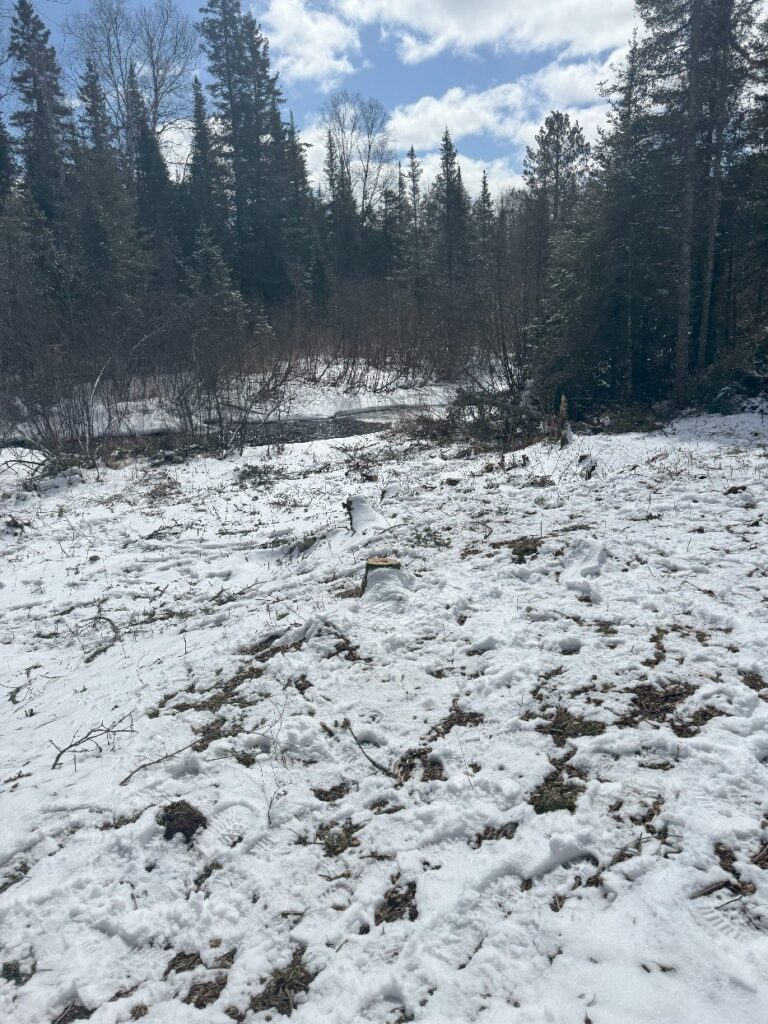MNTU Kicks Off the Field Season with a Riparian Forestry Project on the Sucker River
Minnesota Trout Unlimited is dedicated to preserving and improving the health of trout streams across the state. During these cold weeks of early spring, we’ve kicked off our first project of the year in the Sucker River watershed, a top-tier brook trout and steelhead stream east of Duluth. We’re implementing a tree planting project to combat the detrimental effects of the spruce budworm infestation, caused by a native pest recently boosted by climate change. This month, our work focuses on clearing dead and dying stands of balsam and spruce in small clearings approximately 50 feet in diameter or 2,000 square feet, adjacent to the stream. Later this spring, we’ll plant thousands of long-lived coniferous and deciduous trees, which will restore shade to the stream and other ecological benefits associated with healthy riparian forests.
Gap Planting and Its Role Against Spruce Budworm as the Climate Changes
Climate change has created conditions that favor the proliferation of the spruce budworm. Warmer temperatures and altered precipitation patterns have stressed forest ecosystems, making trees more vulnerable to pests. Milder winters fail to suppress insect populations, allowing the spruce budworm to thrive and expand its range. This native insect primarily targets balsam fir and white spruce, leading to significant defoliation and tree mortality. In northeast Minnesota, it’s estimated that over 700,000 acres of balsam fir and white spruce have been affected by the current outbreak, highlighting the urgent need for intervention. The strategy? Gap planting. Gap planting involves introducing a diverse mix of tree species into openings or degraded areas within riparian forest canopy. In the context of the Sucker River watershed, this strategy is particularly effective against the damage caused by the spruce budworm. By planting a variety of conifers and deciduous trees, such as white cedar, white pine, bur oak, and yellow birch, we aim to increase forest resilience and reduce the dominance of species susceptible to spruce budworm. This approach not only mitigates current infestations but also enhances the forest’s ability to withstand future outbreaks.

Trout Habitat Beyond the Banks
Why is an organization with a mission to protect, restore and sustain coldwater fisheries and their watersheds taking on a forestry project? Because riparian forests – those adjacent to streams and rivers – play a vital role in maintaining healthy trout habitats, especially as climate change threatens these ecosystems. The canopy provided by riparian trees offers essential shade, regulating water temperatures to levels suitable for trout survival. Without adequate shading, increased sunlight can elevate water temperatures, stressing trout populations and disrupting their life cycles. Furthermore, riparian vegetation stabilizes stream banks, reducing erosion and sedimentation that can degrade spawning grounds and diminish water quality. The input of organic material from these forests also supports the aquatic food web, providing nutrients and habitat for insects that serve as a primary food source for trout. MNTU has identified this type of work as being a top priority in supporting better, more resilient habitat in northeast Minnesota trout streams.

Project timeline:
- Step 1: This winter, we used aerial geospatial imagery and field surveys to identify stands of dead and dying trees within the Sucker River watershed..
- Step 2: In the field, we’ve been marking planned gaps with flagging tape, creating oval or oblong shapes (approx. 2,000 square feet each) to get healthy trees rapidly established closest to the stream, where shade is critical. Gaps are spaced out by a minimum of 100 feet, alternating sides of the stream.
- Step 3: Once gaps have been marked, sawyers are clearing the dead and dying trees, leaving the organic material in a way that continues to provide habitat and nutrients while creating sunny gaps where new trees can thrive.
- Step 4: Later this spring, we’ll work with professional crews and local volunteers to plant 20 trees in each gap – aiming for a mix of long-lived species – 75% coniferous and 25% deciduous native species.
- Step 5: We’ll continue to monitor the trees over the next several years, providing any brushing or other maintenance needed to optimize growth.
In total, we’re aiming to clear 240 gaps of dead and dying trees, followed by the planting of nearly 5,000 new trees this spring.

Collaborative Efforts and Future Outlook
The success of such projects relies on collaboration among conservation organizations, government agencies, and local communities. To make this project happen, we’ve worked closely with MN DNR Fisheries, Gitche Gumee Chapter Trout Unlimited, local landowners, professional stream restoration consultants, and hard-working crews from Conservation Corps Minnesota and local forest service providers. Work will be reimbursed from the Outdoor Heritage Fund.
Stay tuned – we’ll keep you updated on our progress!
(Phot0 features crews from Conservation Corps Minnesota use chainsaws to clear dead and dying trees along the Sucker River in March 2025.)

